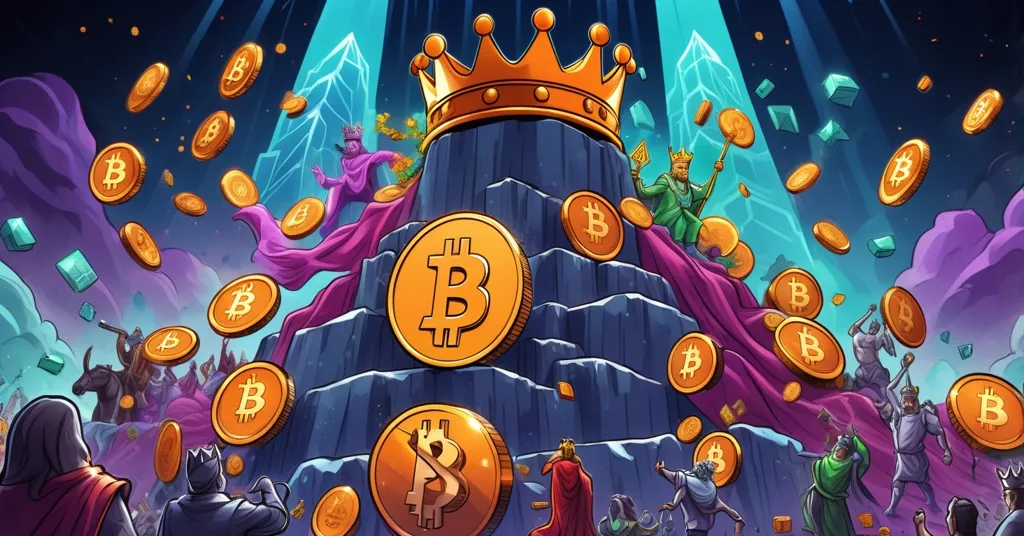Altcoin Season 2025: Top 5 Altcoins to Watch as Bitcoin Dominance Falls to 60%

Altcoin Season 2025: Top 5 Altcoins to Watch as Bitcoin Dominance Drops (July 16-17)
Bitcoin’s iron grip on the crypto market is slipping, and as of mid-July 2025, a fiery altcoin season is taking hold. With Bitcoin dominance tumbling from 63% to 60% in just a week and Ethereum surging past $3,000, capital is flooding into alternative cryptocurrencies, igniting explosive potential in select projects. Let’s unpack this shift and spotlight five altcoins poised for growth—while keeping a sharp eye on the pitfalls.
- Market Pivot: Bitcoin dominance dips to 60%, while the total crypto market cap excluding BTC hits $1.34 trillion, a peak not seen since April 2025.
- Standout Altcoins: Sui (SUI), Arbitrum (ARB), Avalanche (AVAX), Hedera (HBAR), and Chainlink (LINK) lead with strong catalysts.
- Driving Forces: Institutional adoption, technical breakouts, and cutting-edge innovations fuel these altcoin rallies.
The Altcoin Season Surge: What’s Happening?
The crypto market is undergoing a seismic shift right now. Bitcoin dominance—a metric showing BTC’s share of the total crypto market cap—has dropped sharply, signaling that investors are rotating funds into altcoins, the vast array of cryptocurrencies beyond Bitcoin. Meanwhile, the total market cap excluding Bitcoin, often referred to as TOTAL2, has soared to $1.34 trillion, the highest since April 2025, confirming a robust altcoin rally. Ethereum, the heavyweight of smart contract platforms, is at the forefront, smashing through $3,000 for the first time in five months and flipping the ETH/BTC ratio. For the uninitiated, this ratio measures Ethereum’s value relative to Bitcoin, and a reversal often acts as a green light for broader altcoin momentum.
This isn’t just random hype. Historical patterns show altcoin seasons typically emerge after Bitcoin stabilizes or peaks, as traders chase higher-risk, higher-reward opportunities in smaller projects. From Layer 1 blockchains challenging Ethereum’s turf to decentralized finance (DeFi) protocols and AI-driven innovations, the landscape is ripe with opportunity. But let’s be real: these rallies can burn out fast, and not every altcoin is a gem. We’re diving deep into five standout projects showing bullish signals, dissecting their strengths, and throwing in some hard truths about the risks. Buckle up—this is the wild ride of crypto at its finest. If you’re curious about what defines this trend, check out this detailed explanation of Altcoin Season 2025.
Historical Context: Lessons from Past Altcoin Seasons
Before we zoom into specific picks, a quick history lesson. Altcoin seasons aren’t new; they’ve been a recurring phenomenon since the early days of crypto. Think back to 2017, when the ICO (Initial Coin Offering) boom saw hundreds of altcoins skyrocket—many on nothing but whitepaper promises—before 90% crashed into oblivion. Or 2021, when DeFi tokens and NFT projects pumped hard, only for overbought conditions and regulatory jabs to trigger brutal pullbacks. These cycles often kick off when Bitcoin’s dominance wanes, especially post-halving or during Ethereum upgrades that boost market confidence. For deeper insights into these market shifts, take a look at this analysis of Bitcoin dominance drop in July 2025.
What’s the takeaway for 2025? Ethereum’s strength above $3,000 mirrors past triggers, and Bitcoin’s dip to 60% dominance fits the pattern. But history also warns us: overbought signals—like a high Relative Strength Index (RSI)—and sudden shifts in risk sentiment can flip the script overnight. Altcoin euphoria often precedes capital cycling back to Bitcoin as a safe haven. Keep this in mind as we explore the hot picks of this cycle—past gains don’t guarantee future glory.
Top 5 Altcoins Flashing Bullish Signals
Layer 1 Innovators: Sui (SUI) and Avalanche (AVAX)
Sui (SUI) is stealing the spotlight as a Layer 1 blockchain—basically, a foundational network like Ethereum or Bitcoin, built for speed and scalability. Its Total Value Locked (TVL), which measures assets staked in its smart contracts, has hit a staggering $2.326 billion (though some trackers note $2.2 billion due to real-time fluctuations), an all-time high as of July 2025. On July 15 alone, Sui saw net inflows of $1.57 million, a clear sign of investor hunger. What’s fueling this? A partnership with Google Cloud to integrate AI tools for Web3 developers, plus heavy-hitting institutional validators like HSBC and DBS securing the network. Beyond DeFi, Sui’s pushing mainstream adoption with a TikTok pilot for creator monetization in Southeast Asia—imagine influencers earning directly via blockchain. Tech upgrades like zkLogin, a password-less access tool, further sweeten the deal for user onboarding. Learn more about these developments through this report on Sui’s TVL and partnerships.
Price-wise, SUI has blasted through the $3.20–$3.40 resistance zone, peaking near $4.00, with analysts targeting $5.00. That’s hotter than a summer BBQ, but don’t get burned—such rapid surges often invite profit-taking or corrections. A deeper concern is regulatory heat; Southeast Asian markets could scrutinize initiatives like the TikTok pilot, potentially slowing adoption. Still, Sui’s blending of tech innovation and real-world utility screams potential for those betting on blockchain’s mainstream breakout. Dive into more details on their ecosystem via the official Sui blockchain page.
Avalanche (AVAX), another Layer 1 contender, is carving a niche with enterprise-grade solutions. Back in May 2025, FIFA tapped Avalanche to power its FIFA+ collectibles platform, ditching Algorand in a move that highlights AVAX’s scalability for global applications. This isn’t fresh news, but it’s a cornerstone of their momentum. Add to that the “Avalanche 9000” upgrade, which enables custom chains (formerly subnets) for tailored business needs, and you’ve got a platform eyeing serious institutional adoption. As John Nahas, Chief Business Officer at Ava Labs, noted:
“Avalanche is designed for enterprises and organizations looking to build custom, high-performance blockchain solutions. FIFA’s decision to launch its L1 on Avalanche is a testament to our technology’s ability to support global-scale applications with speed, flexibility, and security.”
On the charts, AVAX has broken past $20.36, with sights set on $25.61. Fundamentals look solid, but let’s play skeptic: has the market already priced in the FIFA deal? And while Avalanche touts energy efficiency, critics in the crypto community question whether its architecture sacrifices some decentralization for speed. Worth a ponder for long-term holders. For more on this partnership, see the update on Avalanche and FIFA’s collaboration.
Scaling Solutions: Arbitrum (ARB)
Arbitrum (ARB) is a Layer 2 scaling solution for Ethereum, meaning it’s a secondary network built to slash transaction costs and boost speed while piggybacking on Ethereum’s rock-solid security. Its Timeboost system—a tool to prioritize transaction ordering for efficiency—has raked in over $2 million in fees since April 2025, per data from The Block. Arbitrum powers nearly a third of all decentralized exchange (DEX) trades, cementing its dominance in DeFi, where users swap tokens without middlemen. The Arbitrum DAO treasury, holding 3.5 billion ARB tokens (about $1.3 billion), is a war chest for future growth.
Technically, ARB is retesting a support range of $0.414–$0.420, a level where buyers tend to step in, potentially signaling a bounce if demand holds. Analysts see upside to $1.40–$1.60 if momentum persists. For newbies, Layer 2s are crucial to fixing Ethereum’s high gas fees, but Arbitrum isn’t alone—rivals like Optimism are hot on its heels. A broader market slump could also dampen DeFi activity, hitting ARB hard. Still, its footprint in decentralized trading makes it a heavyweight in this altcoin rally.
Cross-Chain and Enterprise Leaders: Hedera (HBAR) and Chainlink (LINK)
Hedera (HBAR) operates on a different tech structure called hashgraph, which processes transactions faster and with less energy than traditional blockchains. It’s gaining serious traction with institutional players—Grayscale recently added HBAR to its Smart Contract Platform Fund, replacing Polkadot, while banks like Shinhan and Standard Bank are piloting stablecoins (digital currencies pegged to fiat) on its network. These moves signal real-world financial integration, a holy grail for blockchain adoption. Get further insights into Hedera’s momentum from this report on HBAR and altcoin trends.
Price action shows HBAR breaking above $0.22, targeting $0.28–$0.30. But here’s the dirty truth: its RSI sits at 78, a screaming red flag for overbought conditions that could trigger a pullback. For those new to trading lingo, RSI measures momentum, and above 70 often means a price has climbed too fast, too soon. Hedera’s enterprise focus is promising, but institutional ties could also invite centralization concerns—something crypto purists loathe. Keep a wary eye on this one.
Chainlink (LINK) is the backbone of decentralized oracles—systems that feed real-world data (like stock prices or weather) into blockchain smart contracts, making DeFi and other apps functional. Through Project Guardian, Chainlink is enabling interoperability for tokenized funds, linking banks to blockchain tech. Its Cross-Chain Interoperability Protocol (CCIP), recently launched on Hedera, facilitates seamless data and asset transfers across networks. On-chain metrics show whales (big investors) and fund managers piling in, eyeing LINK’s role in tokenized real-world assets (RWAs)—think digital versions of property or bonds—and cross-chain DeFi.
While exact price targets are murkier, the fundamentals scream upside as adoption grows. A specific use case worth noting: CCIP on Hedera lets developers build apps that pull data across blockchains, say, for a stablecoin payment system spanning multiple networks. This is huge for bridging traditional finance and crypto. However, if DeFi momentum stalls or tokenized asset hype fizzles, LINK could feel the pinch. It’s the unsung hero of the space, but not invincible.
Risks and Counterpoints: Don’t Drink the FOMO Kool-Aid
Altcoin seasons are a thrill ride, often delivering jaw-dropping gains for those who time it right. But let’s cut the BS—these rallies can crash harder than a house of cards in a windstorm. Historical data backs this up: the 2021 DeFi boom saw tokens like SushiSwap surge 10x before shedding 80% in weeks. Overbought signals, like Hedera’s RSI at 78, are flashing warnings now. Then there’s Bitcoin itself—maximalists argue, with some merit, that BTC is the only true decentralized store of value. Altcoin pumps often precede capital flowing back to Bitcoin for stability, a cycle we’ve seen time and again.
Beyond market dynamics, external risks loom large. Regulatory scrutiny is a constant shadow—projects tied to DeFi or stablecoins, like Hedera or Chainlink, sit squarely in the crosshairs of agencies like the SEC, especially if 2025 brings tighter rules. Macroeconomic headwinds, such as potential interest rate hikes squeezing risk assets, could also sour the mood for altcoins. And let’s not ignore philosophical debates: institutional backing, while a credibility boost, raises eyebrows. Are networks like Sui, with HSBC as a validator, drifting toward centralization, betraying crypto’s core ethos? It’s a valid jab worth wrestling with. For community perspectives on these trends, explore this Reddit discussion on Altcoin Season 2025 projects.
On the flip side, altcoins aren’t just shiny distractions. They fill niches Bitcoin can’t—or shouldn’t—touch. Layer 1s like Sui offer scalability for mass adoption, Layer 2s like Arbitrum solve real pain points in cost, and oracles like Chainlink bridge decentralized tech with the real world. Innovation matters, and dismissing altcoins as “shitcoins” ignores their role in pushing blockchain forward. Still, blind hype is a fool’s game—volatility rules here, and only the sharp survive.
Bitcoin Maximalist Lens: The King Still Reigns?
As much as we champion disruption and decentralization, a nod to Bitcoin maximalism keeps us grounded. Bitcoin remains the bedrock of this space—unrivaled in its security, network effect, and ethos of freedom from centralized control. Altcoin seasons, while exciting, often act as fleeting sideshows; capital tends to cycle back to BTC when uncertainty hits or after altcoin euphoria peaks. For every 10x altcoin story, there’s a graveyard of forgotten tokens that pumped and dumped. Bitcoin, for all its lack of “sexy” features, is the ultimate hedge against that chaos. So, while we dive into these altcoin opportunities, remember: BTC might just be biding its time to reclaim the throne.
Future Outlook: How Long Can This Altcoin Rally Last?
Peering ahead, the longevity of this 2025 altcoin season is anyone’s guess. Ethereum’s continued strength, especially if rumored upgrades like full sharding roll out by Q3, could sustain momentum for smart contract platforms and DeFi tokens. Institutional adoption—think more FIFA-style deals or bank-backed stablecoins—might further legitimize projects like Avalanche and Hedera, drawing fresh capital. But the flip side is stark: if Bitcoin stages a comeback post-stabilization, or if macro conditions turn sour, altcoin gains could evaporate fast. Will these underdogs finally outshine the king, or is this just another flash in the pan? Dig into these projects yourself—check their whitepapers, track on-chain activity, and don’t ride the hype train blindly. For additional opinions on promising coins, see this Quora thread on top altcoins for 2025.
Key Questions and Takeaways
- What’s driving the altcoin season in July 2025?
Bitcoin dominance dropping to 60% from 63%, paired with Ethereum’s surge past $3,000 and a flipping ETH/BTC ratio, signals capital rotating into altcoins, mirroring historical cycles. - Which altcoins stand out for potential growth?
Sui (SUI), Arbitrum (ARB), Avalanche (AVAX), Hedera (HBAR), and Chainlink (LINK) lead due to institutional backing, partnerships, and innovations like Sui’s AI tools and Chainlink’s cross-chain tech. - Could this altcoin rally crash and burn?
Absolutely—overbought indicators like Hedera’s RSI at 78, Bitcoin dominance recovery, regulatory pressures, and macro risks could trigger sharp reversals. - How does institutional involvement shape altcoin prospects?
Backing from giants like HSBC, FIFA, and Grayscale boosts credibility for Sui, Avalanche, and Hedera, attracting capital and reinforcing long-term adoption potential. - Should Bitcoin remain the priority despite altcoin gains?
For maximalists, yes—Bitcoin’s unmatched decentralization and stability make it the core asset, with altcoin rallies often preceding a return to BTC as a safe haven.
Zooming out, this altcoin season underscores the maturation of the crypto space. Layer 1s like Sui and Avalanche are challenging the status quo with scalable, enterprise-ready tech, while Layer 2s like Arbitrum tackle practical barriers to adoption. Projects like Chainlink and Hedera are forging bridges to traditional finance, proving blockchain’s utility beyond speculation. Yet, for every leap forward, there’s a potential stumble—be it overbought markets, regulatory clampdowns, or the market’s fickle nature. As advocates for decentralization and effective accelerationism, we’re hyped to see these innovations unfold, but we’re not here to peddle pipe dreams. Stay sharp, diversify your bets, and question everything. This is high-stakes poker, and only the savviest players walk away with the pot. If you’re looking for more recommendations, check out this list of top altcoins to buy in July 2025.



